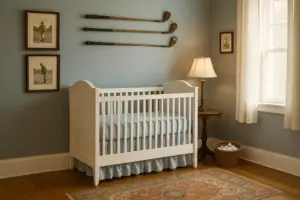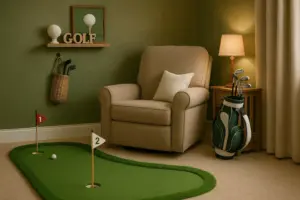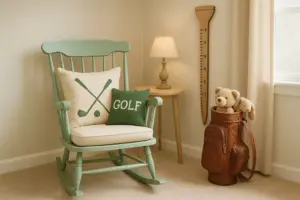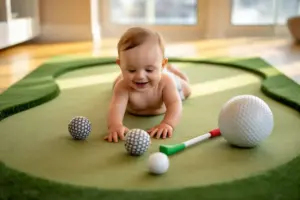7 Perfect Golf Nursery Baby Boy Paint Colors That Bring the Course Indoors
Picture this: Your little one’s first nursery could be where their love for golf begins, surrounded by the serene greens and calming blues that make the golf course such a peaceful retreat. Creating a golf-themed nursery doesn’t mean covering the walls with cartoon golf clubs or bright, overwhelming patterns. Instead, the most sophisticated approach lies in choosing paint colors that capture the essence of the golf course while creating a soothing environment perfect for your baby boy’s development.
Key Takeaways
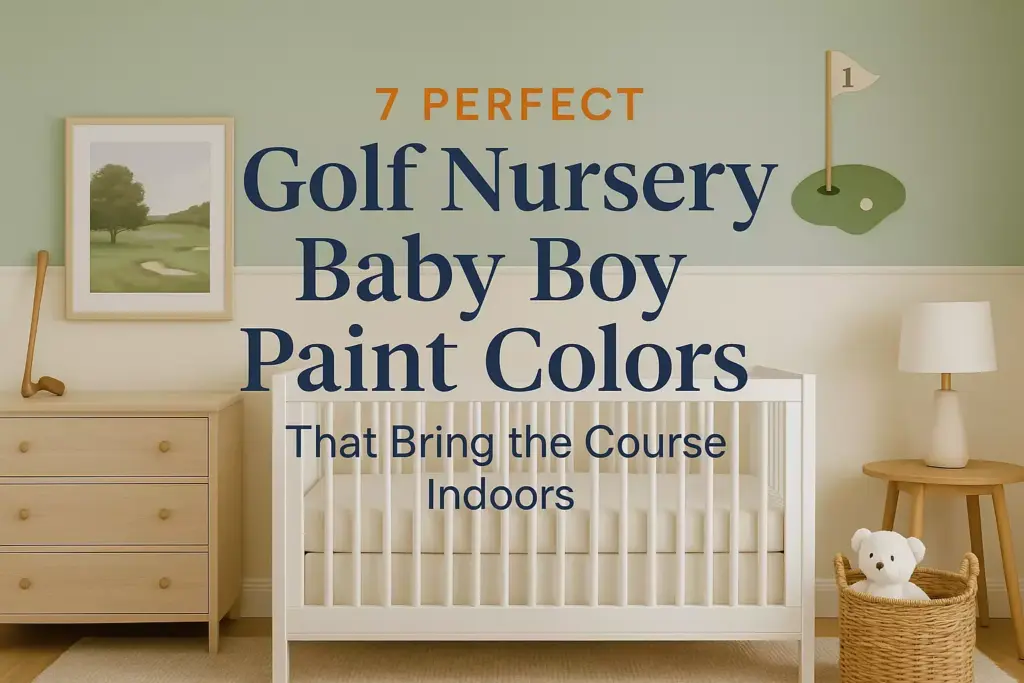
- Sage Green and Forest Green create the foundation of any golf-inspired nursery, mimicking the lush fairways and natural landscapes of premier golf courses
- Sky Blue and Navy Blue add depth and tranquility, representing the open skies above golf courses while promoting better sleep
- Warm Cream and Khaki Tan provide neutral balance and sophistication, preventing the room from becoming too saturated with bold colors
- Charcoal Gray serves as an elegant accent color that grounds the palette and adds modern sophistication
- The key to success lies in combining 2-3 colors maximum, using the 60-30-10 rule for balanced color distribution
Understanding Golf Course Color Psychology for Nurseries
Before diving into specific paint colors, it’s essential to understand why golf course-inspired colors work so beautifully in nurseries. Golf courses represent some of nature’s most carefully curated landscapes, designed to be both challenging and peaceful. The colors found on golf courses—from the various shades of green in the grass to the blues of water hazards and skies—have been proven to promote relaxation and focus.
Research shows that green colors can reduce eye strain and promote feelings of balance and harmony, while blues are known to lower heart rate and create a sense of calm. These psychological benefits make golf course colors ideal for creating a nursery environment that supports both rest and healthy development.
Color #1: Sage Green – The Fairway Foundation

Sage green serves as the perfect primary color for a golf nursery, capturing the essence of well-maintained fairways without being too bold or overwhelming. This muted, grayish-green shade offers sophistication while maintaining the natural golf course connection.
Why Sage Green Works:
- Versatility: Pairs beautifully with both warm and cool accent colors
- Gender-neutral appeal: Works for future siblings or room transitions
- Calming properties: Promotes restful sleep and peaceful play
- Natural light enhancement: Reflects light beautifully throughout the day
Application Tips:
Use sage green on three walls, leaving one wall for a complementary accent color. This creates visual interest without overwhelming the space. Consider using sage green in a matte or eggshell finish to reduce glare and create a more sophisticated appearance.
Complementary Decor Elements:
Sage green walls pair perfectly with white or cream trim, natural wood furniture, and brass or bronze hardware. Add texture through woven baskets, linen curtains, and soft area rugs in neutral tones.
Color #2: Sky Blue – Open Fairway Skies
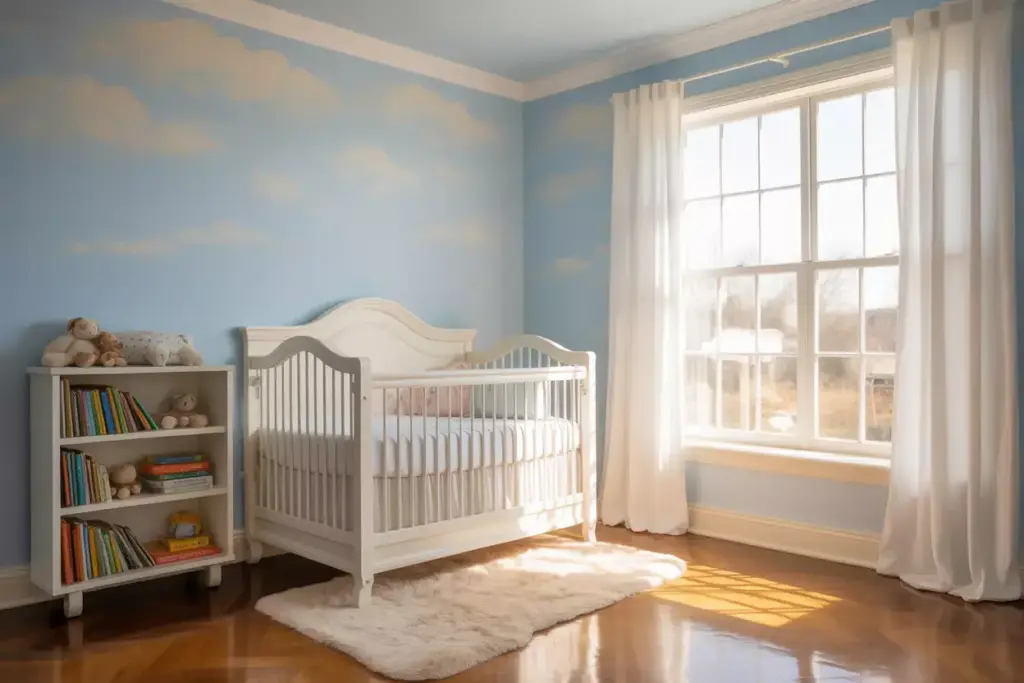
Sky blue brings the expansive feeling of golf course skies indoors, creating an airy, open atmosphere that prevents the nursery from feeling cramped or closed-in. This soft, powder blue shade works exceptionally well as an accent wall or ceiling color.
Benefits of Sky Blue:
- Space enhancement: Makes rooms appear larger and more open
- Sleep promotion: Blue tones are scientifically proven to improve sleep quality
- Temperature perception: Creates a cooler feeling in warm climates
- Timeless appeal: Never goes out of style and grows with the child
Strategic Placement:
Consider painting the ceiling sky blue to create the illusion of being outdoors under an open sky. Alternatively, use sky blue on the wall behind the crib to create a focal point that’s both calming and visually appealing.
Accent Coordination:
Sky blue works beautifully with white clouds painted subtly on the walls, or with wall decals featuring simple, elegant cloud shapes. Avoid cartoon-like decorations in favor of more sophisticated, artistic interpretations.
Color #3: Forest Green – Deep Course Character

For parents who want a richer, more dramatic golf course feel, forest green provides the depth and character of mature golf course landscapes. This deeper green shade works best as an accent color rather than the primary wall color.
Forest Green Applications:
- Accent wall: Behind a reading chair or changing station
- Wainscoting: Lower half of walls for a classic, club-like feel
- Built-in furniture: Bookshelves or window seats
- Ceiling details: Crown molding or ceiling medallions
Balancing Forest Green:
Since forest green is quite bold, balance it with plenty of white or cream trim and lighter colored furnishings. Natural wood elements help warm up the space and prevent it from feeling too dark or masculine.
Lighting Considerations:
Rooms with forest green accents require careful lighting planning. Ensure adequate natural light and supplement with warm white LED lighting to maintain a cozy, welcoming atmosphere.
Color #4: Warm Cream – Clubhouse Elegance

Warm cream serves as the sophisticated neutral that ties golf nursery color schemes together. This color represents the elegant interiors of upscale golf clubhouses and provides a timeless backdrop that won’t compete with decorative elements.
Cream Color Benefits:
- Light reflection: Maximizes natural light in the room
- Flexibility: Works with any accent color combination
- Sophistication: Creates an upscale, refined atmosphere
- Longevity: Won’t look dated as trends change
Using Cream Effectively:
Warm cream works beautifully on trim, ceiling, and as a main wall color when combined with colorful accents. Choose cream shades with slight yellow or beige undertones rather than stark white to maintain warmth.
Texture and Interest:
Since cream can sometimes feel plain, add visual interest through textured paint techniques, such as subtle color washing or the use of different sheens (matte walls with semi-gloss trim).
Color #5: Navy Blue – Water Hazard Sophistication
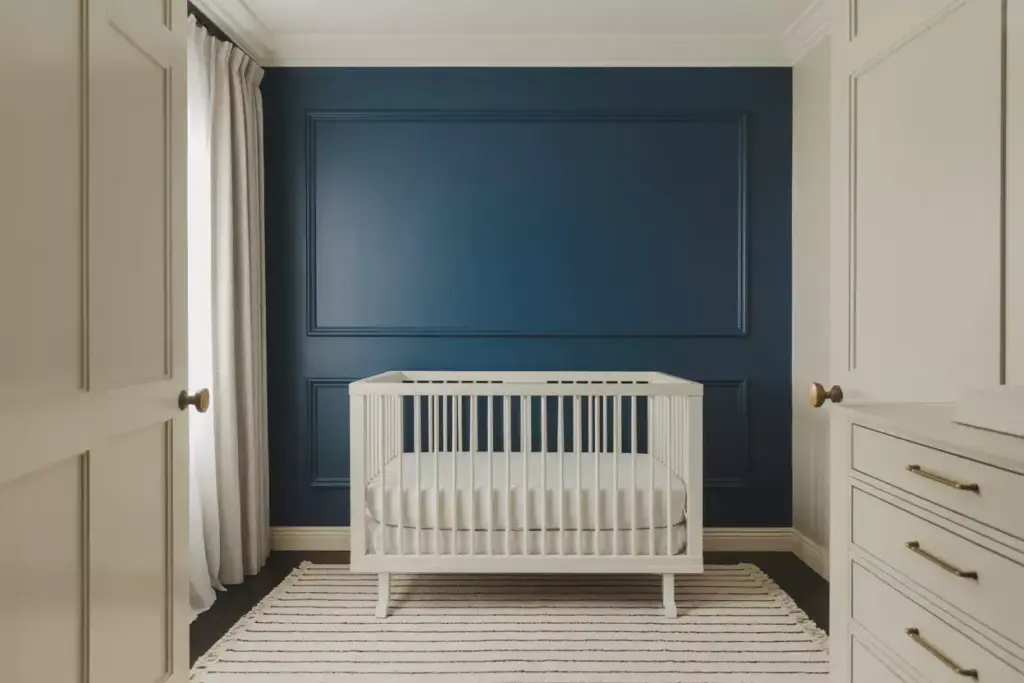
Navy blue brings the sophistication of golf course water hazards and evening skies into the nursery. This deep, rich blue serves as an excellent accent color that adds depth and masculinity without being overwhelming.
Navy Blue Strengths:
- Sophistication: Creates an upscale, mature atmosphere
- Versatility: Pairs with almost any other color
- Gender specificity: Perfect for baby boy nurseries
- Timeless quality: Never goes out of style
Strategic Navy Applications:
Use navy blue sparingly—perhaps on one accent wall, in built-in cabinetry, or as part of a striped pattern with cream or white. Navy works exceptionally well in rooms with plenty of natural light.
Avoiding Overwhelm:
Navy blue can make spaces feel smaller if overused. Limit navy to no more than 25% of the room’s visual space, and always pair with lighter colors to maintain balance.
Color #6: Khaki Tan – Sand Trap Serenity

Khaki tan represents the natural sand elements found on golf courses while providing a warm, neutral base that’s both sophisticated and calming. This earthy tone works beautifully in nurseries with abundant natural light.
Khaki Tan Advantages:
- Warmth: Creates a cozy, inviting atmosphere
- Natural feel: Connects the room to outdoor golf environments
- Versatility: Complements both cool and warm accent colors
- Sophistication: More interesting than plain beige or tan
Implementation Ideas:
Khaki tan works well as a main wall color in rooms with white trim and colorful accents, or as an accent color paired with sage green or sky blue primary walls.
Avoiding Blandness:
To prevent khaki tan from feeling boring, incorporate varied textures, patterns, and accent colors. Consider adding interest through geometric patterns, natural wood elements, or metallic accents.
Color #7: Charcoal Gray – Modern Course Architecture
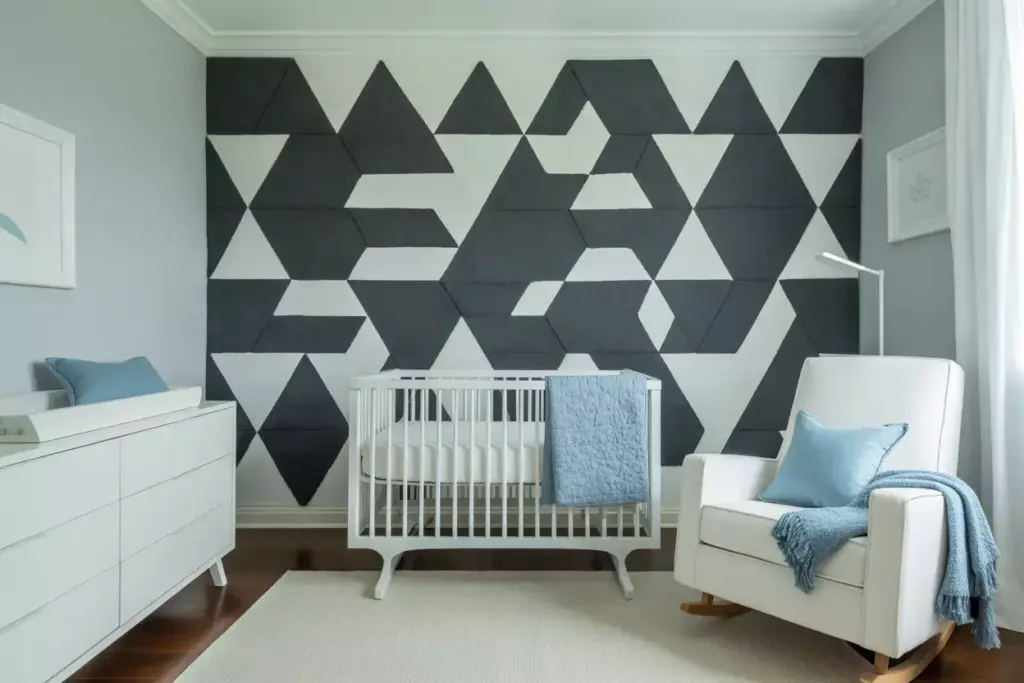
Charcoal gray represents the modern architectural elements found in contemporary golf course design—from cart paths to modern clubhouse exteriors. This sophisticated neutral adds contemporary flair while remaining timeless.
Charcoal Gray Benefits:
- Modern appeal: Creates a contemporary, stylish atmosphere
- Grounding effect: Anchors lighter colors in the room
- Sophistication: Adds upscale, designer appeal
- Flexibility: Works with any color combination
Best Applications:
Charcoal gray works exceptionally well as an accent wall, in furniture pieces, or as part of a geometric pattern. Use sparingly to avoid creating a space that feels too dark or serious for a baby.
Balancing Techniques:
Always balance charcoal gray with plenty of lighter colors and ensure adequate lighting. Consider using charcoal gray in areas that receive good natural light, such as walls with large windows.
🏌️ Golf Nursery Color Palette Designer
Creating Successful Color Combinations
The secret to a successful golf nursery lies not just in choosing the right individual colors, but in combining them effectively. The most successful golf nurseries use 2-3 colors maximum, following the classic interior design rule of 60-30-10.
The 60-30-10 Rule Explained:
- 60%: Dominant color (usually a neutral like warm cream or sage green)
- 30%: Secondary color (a complementary golf course color)
- 10%: Accent color (used sparingly for visual interest)
Winning Color Combinations:
Classic Golf Course: Sage Green (60%) + Warm Cream (30%) + Navy Blue (10%)
Sky and Fairway: Sky Blue (60%) + Sage Green (30%) + Charcoal Gray (10%)
Sophisticated Links: Warm Cream (60%) + Forest Green (30%) + Khaki Tan (10%)
Modern Course: Charcoal Gray (60%) + Sky Blue (30%) + Sage Green (10%)
Practical Application Tips
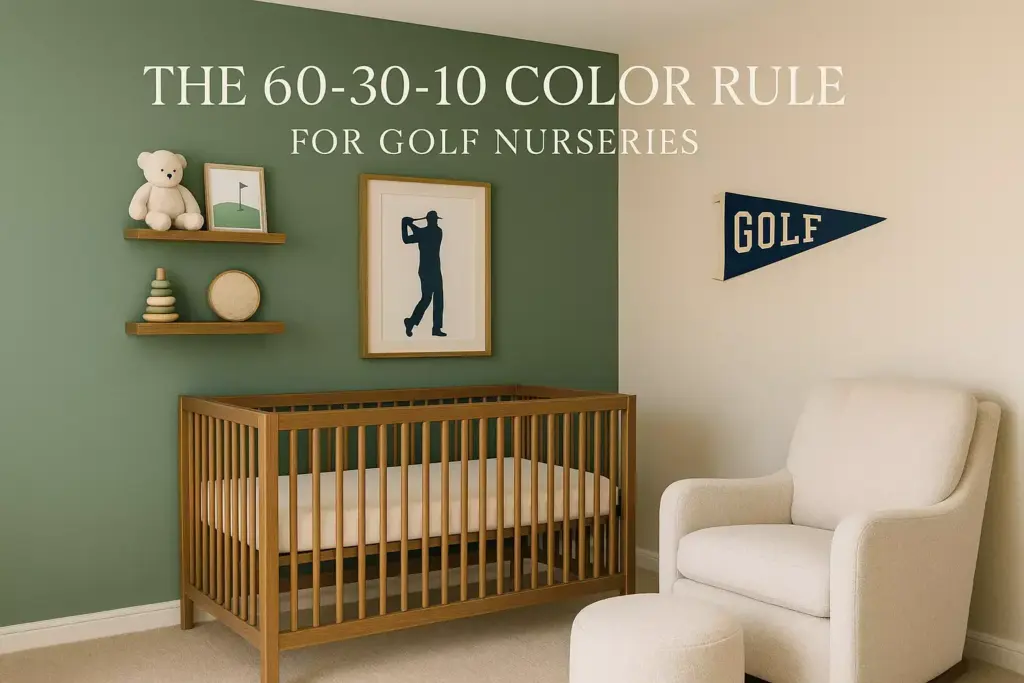
Lighting Considerations
Natural light plays a crucial role in how golf nursery colors appear throughout the day. Test paint colors in different lighting conditions before making final decisions:
- Morning light: Tends to be cooler, making warm colors appear more muted
- Afternoon light: Warmer and brighter, can intensify cool colors
- Evening light: Warmer and softer, making all colors appear more golden
Paint Finish Selection
Choose appropriate paint finishes for different areas:
- Walls: Eggshell or satin for easy cleaning while maintaining sophistication
- Trim: Semi-gloss for durability and visual contrast
- Ceiling: Flat or matte to minimize imperfections and reduce glare
Sample Testing Process
Always test paint colors before committing:
- Purchase sample sizes of your top 3 color choices
- Paint large swatches (at least 2x2 feet) on different walls
- Observe colors at different times of day for at least 48 hours
- Consider adjacent rooms and how colors flow together
Incorporating Golf Elements Beyond Paint
While paint colors form the foundation of your golf nursery, consider these additional elements to complete the theme:
Subtle Golf Accents:
- Vintage golf prints in sophisticated frames
- Natural wood elements reminiscent of golf course architecture
- Brass or bronze hardware echoing clubhouse fixtures
- Textured fabrics in golf course-inspired colors
Avoiding Overdone Themes:
Stay away from cartoon golf elements or overly literal interpretations. The goal is sophistication and subtlety, creating a room that feels inspired by golf courses rather than a golf shop.
Budget-Friendly Implementation Strategies
Creating a beautiful golf nursery doesn't require a massive budget. Here are cost-effective strategies:
DIY Painting Techniques:
- Color washing: Creates subtle texture and depth
- Geometric patterns: Use painter's tape for clean lines
- Accent walls: Maximum impact with minimal paint
Affordable Decor Solutions:
- Thrift store finds: Refinish furniture in golf course colors
- DIY artwork: Create simple, elegant golf-inspired prints
- Natural elements: Incorporate plants and natural textures
Phased Implementation:
Start with paint and basic furniture, then add decorative elements over time as budget allows.
Safety Considerations for Nursery Painting
When painting a nursery, safety should be the top priority:
Paint Selection:
- Choose low-VOC or zero-VOC paints to minimize harmful fumes
- Look for paints specifically labeled as nursery-safe
- Avoid lead-based paints in older homes
Timing and Ventilation:
- Complete painting at least 2-3 weeks before baby's arrival
- Ensure proper ventilation during and after painting
- Use fans and open windows to circulate fresh air
Professional vs. DIY:
Consider hiring professionals for large projects, especially if you're pregnant or have respiratory sensitivities.
Future-Proofing Your Golf Nursery
Design choices that grow with your child ensure longevity:
Adaptable Elements:
- Choose colors that work for different ages
- Select furniture that can transition from nursery to big-kid room
- Use removable wall decals instead of permanent decorations
Gender-Neutral Options:
Many golf course colors work beautifully for any gender, making future room transitions easier.
Timeless vs. Trendy:
Focus on classic golf course colors rather than current color trends that may quickly become dated.
Conclusion
Creating the perfect golf nursery for your baby boy involves thoughtful color selection that captures the serene beauty of golf courses while providing a nurturing environment for growth and development. The seven colors outlined—Sage Green, Sky Blue, Forest Green, Warm Cream, Navy Blue, Khaki Tan, and Charcoal Gray—offer endless possibilities for creating sophisticated, calming spaces that celebrate the sport you love.
Remember that the most successful golf nurseries use restraint and sophistication rather than overwhelming themes. By choosing 2-3 colors maximum and following the 60-30-10 rule, you'll create a space that feels both golf-inspired and perfectly suited for a baby.
Your next steps:
- Test paint samples in your nursery space over several days
- Choose your color combination using the interactive tool above
- Plan your painting timeline to ensure the room is ready well before baby's arrival
- Start with paint and basic elements, then add decorative touches over time
The investment in creating a thoughtfully designed golf nursery will pay dividends in creating a peaceful, beautiful space where your little golfer can grow, learn, and develop a lifelong appreciation for both the sport and well-designed spaces.
SEO Meta Title: Golf Nursery Paint Colors: 7 Perfect Baby Boy Room Ideas 2025
SEO Meta Description: Discover 7 sophisticated golf-inspired paint colors perfect for baby boy nurseries. Create a calming, course-inspired space with expert color combinations and tips.


